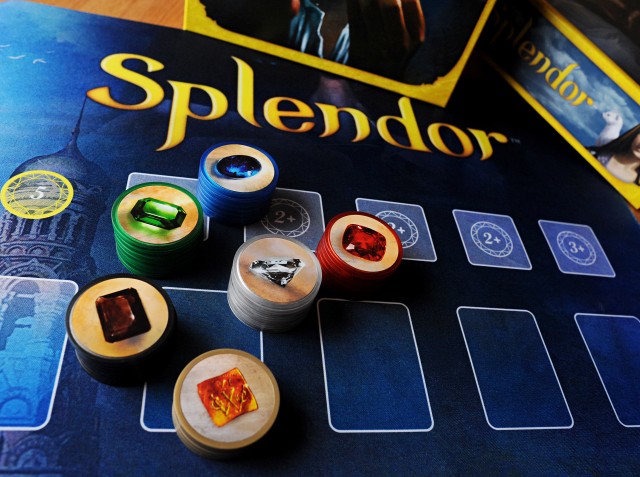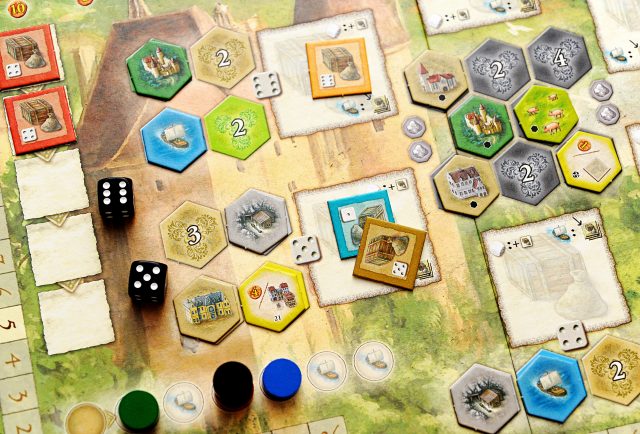Special Guest Contributor Claire S.
((I wish I could take all the credit for what I’m about to write, but in the interest of full disclosure, I will say that most of the main ideas for this piece all came from my partner Claire, a lifelong game-lover but relatively new to the intense subculture of tabletop gaming. I urged her to write it up herself–several times–but she demurred, saying she didn’t know enough about “games”. I thought her insights were too good not to share, so took it upon myself to write them up and expand on them a bit. Hence the byline.))
List your top ten games. Right now. Just do it.
 How many of them are set in the historic Middle Ages, usually either explicitly or by virtue of the graphic design and inferred theme? Chances are you have at least one, and if your tastes run to Eurogames the proportion is probably much higher.
How many of them are set in the historic Middle Ages, usually either explicitly or by virtue of the graphic design and inferred theme? Chances are you have at least one, and if your tastes run to Eurogames the proportion is probably much higher.
Until the advent of Eurogames, the most popular tabletop games in North America were abstracts like chess and checkers, card games like cribbage, gin, and poker, word games like Scrabble or Boggle, or trivia games. Then you had Risk and Stratego, which were originally set in a vaguely Napoleonic period. Finally you had economic games like Monopoly, which was originally invented to inveigle against the tyranny of landlords and property ownership (Don’t believe me? Look it up) and Pit, which elegantly recreated the chaos of the trading floor.
Then came Catan and Carcassonne, and modern tabletop gaming took a turn to the Middle Ages. And not just European: consider Mombasa, Tzolk’in, Senji, Greenland.
Although currently only two of the top twenty-five games on BGG are Medieval (Castles of Burgundy and Agricola), if you look at the Strategy game rankings the number rises to five (add in Orleans, Viticulture, and A Feast For Odin), with four more in a row bubbling under (Keyflower, Fields of Arle, Voyages of Marco Polo, and Caylus). Over in the Family rankings, we’ve got Isle of Skye, Love Letter, Sheriff of Nottingham, and Splendor in the top twenty-five. (Okay, Splendor is Tudor-era, graphically, I’ll give you that.)
It’s got to the point where Medieval traders seems to be a default choice of theme, at least for some publishers and designers–sort of like how movie studios assume a superhero movie will pay off at the box-office.
So why is that? What is it about Medieval Times (aside from the tasty chicken dinners and jousting) that makes it an appealing theme? I/we believe there are five interconnecting reasons why:
 Most games do not focus on finance; on the contrary, designers usually want to focus on other mechanics, and have a simple economic system to support that. Therefore, it makes some sense to set the theme of the game in an era where transactions were similarly straightforward. Hence, Middle Ages.
Most games do not focus on finance; on the contrary, designers usually want to focus on other mechanics, and have a simple economic system to support that. Therefore, it makes some sense to set the theme of the game in an era where transactions were similarly straightforward. Hence, Middle Ages.
2. The Age of Innocence: Mel Brooks once said, “Tragedy plus time equals comedy.” Every era has its popular reputation and stereotypes, usually driven by pop culture. The 60’s were shaggadelic, baby. The 20’s were all gangsters and flappers and hooch. The 1890’s were gaslit and morally repressed. And so on. Of course, some eras are more fraught than others in the popular imagination. 1930’s Germany, for example, or 9/11. The further back in history you go, however, the more removed the tragedies of that time are, and the more rose-coloured the view.
Designers and publishers want people to look at a game and think “Ooh, fun!” They certainly want to avoid, if possible, themes which will make people turn away in revulsion, thinking, “Too soon, dude.” So although the Middle Ages were in fact riven by war, religious chaos, and plague, all that bad stuff happened so long ago that most people are basically neutral at worst when it comes to a game set during that time. It is a blank slate upon which you can set up your world without fear of triggering any negative response.
3. One More Story Before Bedtime: Tied closely with the previous point, humans are a storytelling race, and many of the classic fairy tales we grew up with in North America and Europe were first written down in the Middle Ages: Cinderella, Puss in Boots, Jack & the Beanstalk, etc. Therefore, again although the actual historical record is different, and although many fairy tales are actually quite scary/gory in their original incarnations, the Middle Ages have a nostalgic sheen for many of us because of their association with childhood storytime, and therefore make for an attractive (if anodyne) theme.
 4. The Walking Meeple: As I wrote about a couple of weeks ago, dystopia is all the rage, and has been for some time. How many of us yearn for a simpler age without Snapchat, or live in constant fear of societal collapse? Or both? How soothing then, how like a gentle balm on a troubled soul it is to spend a couple of hours immersed in a simpler time when your whole life revolves around feeding your family, breeding animals, and turning your mud hut into a stone dwelling? How better to reassure yourself that you could survive the collapse of Western civilization than by kicking your friends to the curb and becoming the rootinest, tootinest, most ornery Medieval trader this side of Frankfurt?
4. The Walking Meeple: As I wrote about a couple of weeks ago, dystopia is all the rage, and has been for some time. How many of us yearn for a simpler age without Snapchat, or live in constant fear of societal collapse? Or both? How soothing then, how like a gentle balm on a troubled soul it is to spend a couple of hours immersed in a simpler time when your whole life revolves around feeding your family, breeding animals, and turning your mud hut into a stone dwelling? How better to reassure yourself that you could survive the collapse of Western civilization than by kicking your friends to the curb and becoming the rootinest, tootinest, most ornery Medieval trader this side of Frankfurt?
5. D&D is for Geeks, and I’m not a Geek: Sure you’ve got your steampunk, Federation-wannabe, and cyberpunk universes, but the classic fantasy template established by Tolkien, Brooks, Leiber, et. al. is a world of orcs, elves, walking trees, and wizards slathered on top of a medieval base. But for various reasons some people shy away from RPG’s and fantasy-themed games. Some have religious qualms about the magic component. Some prefer historical themes. And some just have preconceived ideas about the kind of people who “play with dragons” and don’t want to be seen with “that crowd”. These people may yearn to play fantasy, but settle for the next best thing, which is the underlying Medieval world.
And there you are: five reasons why every third game that comes out seems to be about Medieval Traders turning cubes of one colour into cubes of other colours. Is this vein inexhaustible? Will we ever reach “Peak Medieval”? What do you think?
Comments
No comments yet! Be the first!